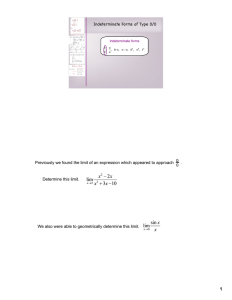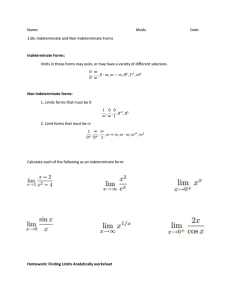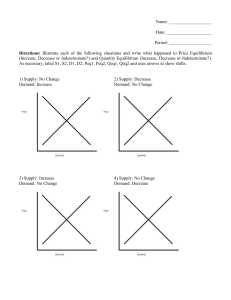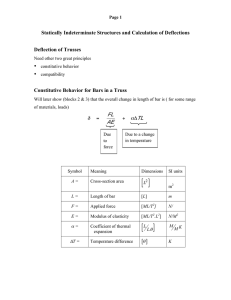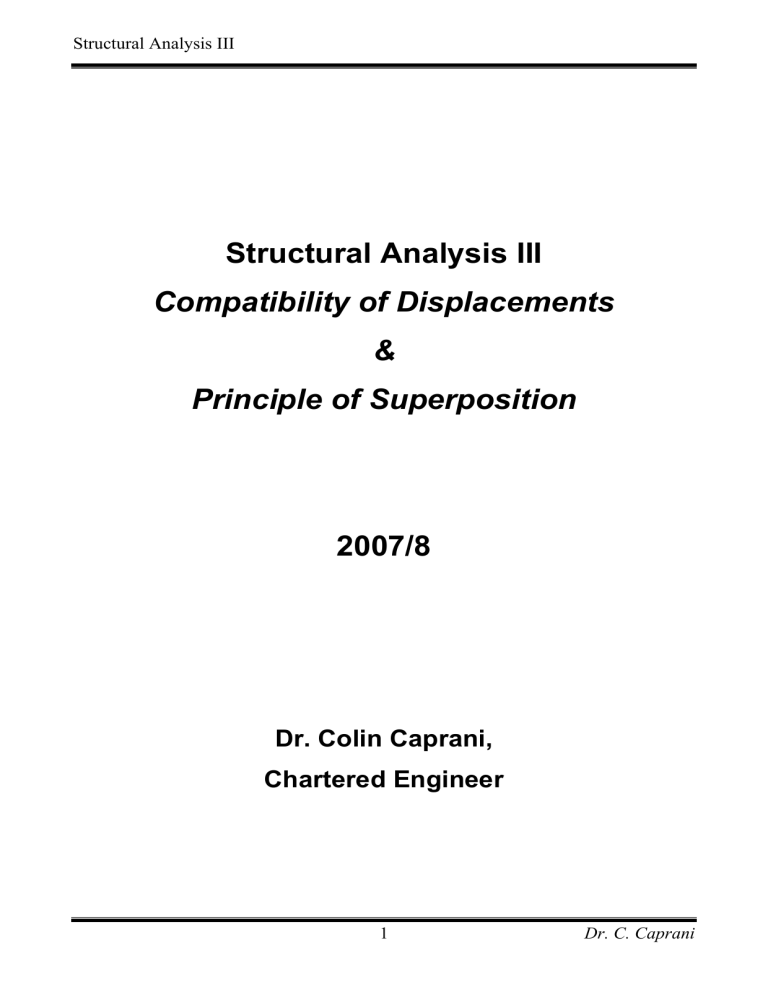
Structural Analysis III Structural Analysis III Compatibility of Displacements & Principle of Superposition 2007/8 Dr. Colin Caprani, Chartered Engineer 1 Dr. C. Caprani Structural Analysis III 1. Introduction 1.1 Background In the case of 2-dimensional structures there are three equations of statics: ∑F = 0 ∑F = 0 ∑M = 0 x y Thus only three unknowns (reactions etc.) can be solved for using these equations alone. Structures that cannot be solved through the equations of static equilibrium alone are known as statically indeterminate structures. These, then, are structures that have more than 3 unknowns to be solved for. In order to solve statically indeterminate structures we must identify other knowns about the structure. These other knowns are usually displacements, such as those at the supports. When these are combined with the principle of superposition, indeterminate structures can be solved. 2 Dr. C. Caprani Structural Analysis III 2. Compatibility of Displacements 2.1 Description When a structure is loaded it deforms under that load. Points that were connected to each other remain connected to each other, though the distance between them may have altered due to the deformation. All the points in a structure do this is such a way that the structure remains fitted together in its original configuration. Compatibility of displacement is thus: Displacements are said to be compatible when the deformed members of a loaded structure continue to fit together. Thus, compatibility means that: • Two initially separate points do not move to another common point; • Holes do not appear as a structure deforms; • Members initially connected together remain connected together. This deceptively simple idea is very powerful when applied to indeterminate structures. 3 Dr. C. Caprani Structural Analysis III 2.2 Examples Truss The following truss is indeterminate. Each of the members has a force in it and consequently undergoes elongation. However, by compatibility of displacements, the elongations must be such that the three members remain connected after loading, even though the truss deforms and Point A moves to Point A’. This is an extra piece of information (or ‘known’) and this helps us solve the structure. Beam The following propped cantilever is an indeterminate structure. However, we know by compatibility of displacements that the deflection at point B is zero before and after loading, since it is a support. 4 Dr. C. Caprani Structural Analysis III Frame The following frame has three members connected at joint B. The load at A causes joint B to rotate anti-clockwise. The ends of the other two members connected at B must also undergo an anti-clockwise rotation at B to maintain compatibility of displacement. Thus all members at B rotate the same amount, θ B , as shown below. Joint B 5 Dr. C. Caprani Structural Analysis III 3. Principle of Superposition 3.1 Development For a linearly elastic structure, load, P, and deformation, δ , are related through stiffness, K, as shown: For an initial load on the structure we have: P1 = K ⋅ δ1 If we instead we had applied ∆P we would have gotten: ∆P = K ⋅ ∆δ Now instead of applying ∆P separately to P1 we apply it after P1 is already applied. The final forces and deflections are got by adding the equations: 6 Dr. C. Caprani Structural Analysis III P1 + ∆P = K ⋅ δ1 + K ⋅ ∆δ = K (δ1 + ∆δ ) But, since from the diagram, P2 = P1 + ∆P and δ 2 = δ1 + ∆δ , we have: P2 = K ⋅ δ 2 which is a result we expected. This result, though again deceptively ‘obvious’, tells us that: • Deflection caused by a force can be added to the deflection caused by another force to get the deflection resulting from both forces being applied; • The order of loading is not important ( ∆P or P1 could be first); • Loads and their resulting load effects can be added or subtracted for a structure. This is the Principle of Superposition: For a linearly elastic structure, the load effects caused by two or more loadings are the sum of the load effects caused by each loading separately. Note that the principle is limited to: • Linear material behaviour only; • Structures undergoing small deformations only (linear geometry). 7 Dr. C. Caprani Structural Analysis III 3.2 Example If we take a simply-supported beam, we can see that its solutions can be arrived at by multiplying the solution of another beam: The above is quite obvious, but not so obvious is that we can also break the beam up as follows: Thus the principle is very flexible and useful in solving structures. 8 Dr. C. Caprani Structural Analysis III 4. Solving Indeterminate Structures 4.1 Introduction Compatibility of displacement along with superposition enables us to solve indeterminate structures. Though we’ll use more specialized techniques they will be fundamentally based upon the preceding ideas. Some simple example applications follow. 9 Dr. C. Caprani Structural Analysis III 4.2 Example: Propped Cantilever Consider the following propped cantilever subject to UDL: Using superposition we can break it up as follows (i.e. we choose a redundant): Next, we consider the deflections of the primary and reactant structures: 10 Dr. C. Caprani Structural Analysis III Now by compatibility of displacements for the original structure, we know that we need to have a final deflection of zero after adding the primary and reactant deflections at B: δ B = δ BP + δ BR = 0 From tables of standard deflections, we have: wL4 RL3 R δ =+ and δ B = − 8 EI 3EI P B In which downwards deflections are taken as positive. Thus we have: wL4 RL3 δB = + − =0 8 EI 3EI 3wL ∴R = 8 Knowing this, we can now solve for any other load effect. For example: wL2 − RL 2 wL2 3wL L = − 2 8 4 wL2 − 3wL2 = 8 2 wL = 8 MA = Note that the wL2 8 term arises without a simply-supported beam in sight! 11 Dr. C. Caprani Structural Analysis III 4.3 Example: 2-Span Beam Considering a 2-span beam, subject to UDL, which has equal spans, we break it up using the principle of superposition: Once again we use compatibility of displacements for the original structure to write: δ B = δ BP + δ BR = 0 Again, from tables of standard deflections, we have: 5w ( 2 L ) 80 wL4 δ =+ =+ 384 EI 384 EI 4 P B 12 Dr. C. Caprani Structural Analysis III And: R ( 2L ) 8 RL3 δ =− =− 48EI 48 EI 3 R B In which downwards deflections are taken as positive. Thus we have: 80 wL4 8 RL3 δB = + − =0 384 EI 48 EI 8 R 80 wL = 48 384 10 wL R= 8 Note that this is conventionally not reduced to 5wL 4 since the other reactions are both 3wL 8 . Show this as an exercise. Further, the moment at B is by superposition: Hence: RL wL2 10wL L wL2 10 wL2 − 8wL2 − = ⋅ − = 2 2 8 2 2 16 2 wL = 8 MB = And again wL2 8 arises! 13 Dr. C. Caprani Structural Analysis III 5. Problems Use compatibility of displacement and the principle of superposition to solve the following structures. In each case draw the bending moment diagram and determine the reactions. 1. 2. 3. This one is tricky: choosing the reaction at C gives R = 3P 8 . 14 Dr. C. Caprani
